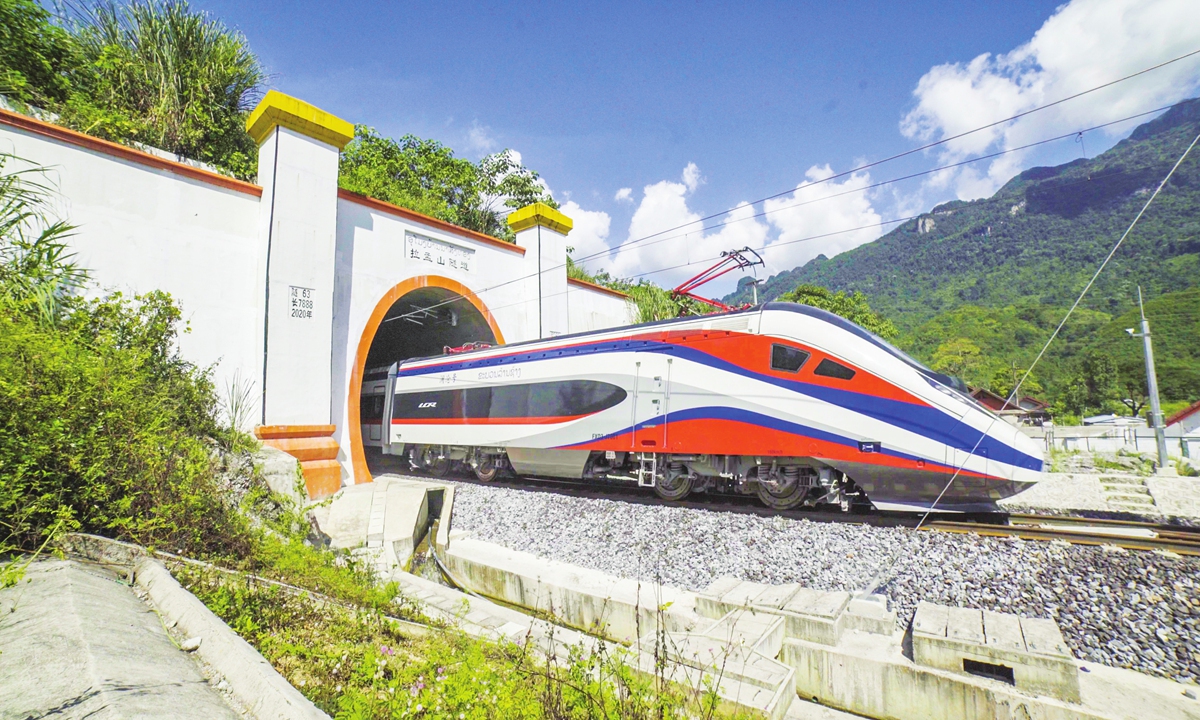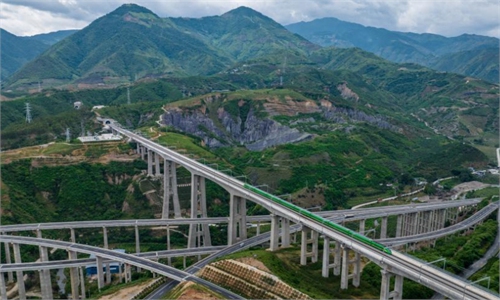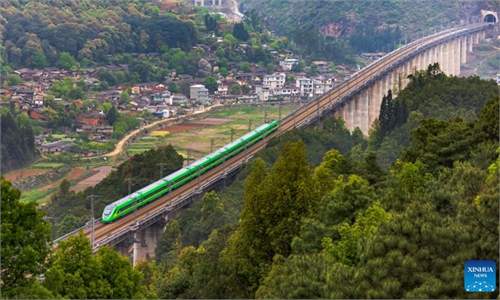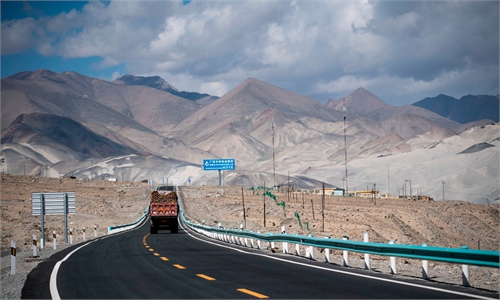BRI accelerates infrastructure connectivity between China, ASEAN: Singaporean scholar

A section of the China-Laos Railway built by PowerChina Photo: Courtesy of PowerChina
Editor's Note:
This year marks the 10th anniversary of the China-proposed Belt and Road Initiative (BRI), a global cooperation platform that demonstrates China's vision and provides solutions to the reform of the global governance system and multifaceted challenges. Against this backdrop, the Global Times is publishing a series of interviews with renowned scholars, think tanks, and financial institutions, sharing their insights and understanding of how the BRI has earned global recognition and reshaped global development. This is the third installment in the series.
Cooperation between China and ASEAN has led to fruitful results under the BRI, and the development dividends have radiated to other countries in the world. Global Times reporter Liu Yang (GT) recently conducted an interview with Yu Hong (Yu), senior research fellow at the East Asian Institute at the National University of Singapore.

Yu Hong Photo: Courtesy of Yu Hong
GT: As the BRI enters its 10th anniversary this year, how do you evaluate the benefits and development opportunities brought by this initiative to the participating economies?
Yu: Under the framework, 150 countries and more than 30 international organizations accounting for 63 percent of the world's population and 40 percent of the global economic output, have signed documents with China. In the past decade, China's "circle of friends" under the BRI has been expanding. If the initiative cannot bring real development opportunities to the participating economies, why are more and more countries taking part in it?
Some countries along the BRI are facing the challenge of population aging or less-developed infrastructure, which affects the improvement of local people's livelihoods and social-economic development. Therefore, one of the biggest development opportunities for countries along the BRI routes is the improvement of large-scale infrastructure connectivity, which brings the possibility of expanding trade and investment, as well as opportunities for the development of manufacturing and service sectors.
With this year marking the 10th anniversary of the China-proposed BRI, areas of the cooperation across the initiative are increasing, demonstrating its adaptability and potential for sustainable development. Over the past 10 years, cooperation has expanded from the initial focus on infrastructure connectivity to a wider range of other fields, including health care, digital economy and cooperation in the Arctic. The expansion of cooperation areas enables the BRI to create new development opportunities for the participating economies.
GT: Looking ahead, what new changes and challenges do you think will emerge from the BRI? How should China face those challenges?
Yu: Ten years on, the BRI now faces a new international situation and new challenges. Compared to 2013, when the initiative was first launched, the regional and global geopolitical situations have changed profoundly. In particular, the geopolitics and the US-led "decoupling" from China are creating new challenges for the BRI implementation.
In addition, the COVID-19 pandemic has had a huge impact on the domestic economic and financial situation of many developing or less developed economies along the BRI, such as Zambia, Kenya, Pakistan and Sri Lanka. As a result, these problems have led to financing difficulties for some BRI projects.
As to the so-called "debt trap", it is hyped by the West. In fact, the debt woes in some BRI economies were resulting from years of accumulation of domestic financial problems. That is to say, it is not the initiative or the projects that have created their debt problems. Evidently, a large share of these countries' debts derives from private commercial firms in the Western countries or contracted from international multilateral institutions. It is therefore unfair or erroneous to blame all the debt problems on the BRI.
GT: There are foreign media reports alleging that China's momentum on the BRI is slowing down as loans decline and projects stall. What is your take on the claim?
Yu: I don't agree. The pandemic has had some negative impacts on the implementation of projects under the BRI, such as hindering the mobility of engineers and disturbing the logistics of raw materials and engineering equipment, which may have slowed down the pace of some projects. However, the overall momentum of investment and advancement of the BRI continues to progress.
As the countries along the route have huge infrastructure needs, they generally remain welcoming and want more Chinese companies to participate in local infrastructure financing and construction. Therefore, China will definitely continue to promote the initiative rather than slowing down, as has been claimed by some Western media.
GT: How do you evaluate the cooperation between China and the Association of Southeast Asian Nations (ASEAN) under the Belt and Road framework?
Yu: ASEAN is a core grouping in the BRI, especially regarding the 21st Century Maritime Silk Road. China is the most important economic partner of the ASEAN. Alongside the China-proposed initiative, the China-ASEAN Free Trade Area and Regional Comprehensive Economic Partnership (RCEP) have enabled broadening and strengthening of bilateral cooperation in trade, infrastructure and investment.
Poor infrastructure and lack of logistics and transportation capacity hinder the economic growth of many developing Southeast Asian countries. A study released by the Asian Development Bank in 2017 said that the Southeast Asia needs to reach a total of $2.75 trillion in infrastructure investment from 2016 to 2030. Therefore, Southeast Asian countries, especially the developing countries, welcome the BRI for its potential to accelerate the connectivity among the ASEAN and drive the development of local infrastructure.
For example, the China-Laos Railway will keep providing dividend effects while potentially turning Laos, a land-locked country, into a land-linked country. Chinese enterprises have built many other projects in Southeast Asian countries. The completion and operation of such projects, bilateral trade and the two-way investment between China and ASEAN offer the opportunity for rapid growth.
Over the past few years, Chinese companies have steadily increased their investment and expanded their markets in Southeast Asia, including e-commerce firms like Alibaba and high-tech companies like Huawei.
GT: What have China and Singapore achieved in their BRI cooperation? What are the prospects for future cooperation between the two?
Yu: Among ASEAN countries, Singapore was the first to support and participate in China's reform and opening-up policy, and has been playing a leading role in the country's foreign trade and economic cooperation. In fact, Singapore companies have been deeply involved in China's opening-up, especially in the progress of regional development.
China and Singapore have four intergovernmental cooperation projects in Suzhou, Tianjin, Chongqing and Guangzhou. The scale of these projects is unique in terms of China's foreign cooperation, reflecting the breadth and depth of Singapore's participation in China's opening-up and development, as well as the special nature of the relationship between the two countries.
Singapore has been the largest source of new investment in China for nine consecutive years since 2013. Singapore's unique position within the BRI derives from its importance as a regional financial centre.
With its professional services in the fields of finance, law and accounting, as well as the fairness and transparency of its open market, Singapore has become an important investment platform and financing center for Chinese companies seeking to go global under the BRI. By expanding their investments in Singapore, Chinese enterprises are looking for suitable partners to jointly develop third-country markets, especially in Southeast Asia.
GT: What efforts have China and Singapore jointly made in facilitating global connectivity?
Yu: The New International Land-Sea Trade Corridor, a flagship project of bilateral cooperation, connects Chongqing and the entire western provinces of China with Southeast Asian countries through Singapore as a whole, using rail-sea intermodal freight trains.
Since the land-sea trade channel came into operation, there has been rapid growth in the volume of goods transport between China and other countries. From 2017 to 2022, the volume of container goods transported via the corridor jumped from 3,382 TEUs to 756,000 TEUs.
Its large-scale operation can effectively reduce the logistics and transportation costs of enterprises in China's western provinces, facilitating exports of local fresh agricultural products to other Southeast Asian countries, the European market and Africa.



